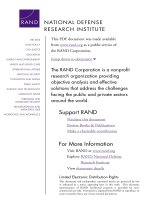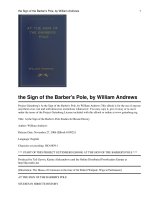Neurite outgrowth inhibitors in axoglial communication at the node of ranvier
Bạn đang xem bản rút gọn của tài liệu. Xem và tải ngay bản đầy đủ của tài liệu tại đây (13.06 MB, 231 trang )
NEURITE OUTGROWTH INHIBITORS IN
AXON-GLIAL COMMUNICATION AT THE NODE OF
RANVIER
DU-YU NIE (M.D.)
A THESIS SUBMITTED FOR THE DEGREE OF
DOCTOR OF PHILOSOPHY
DEPARTMENT OF ANATOMY
NATIONAL UNIVERSITY OF SINGAPORE
2005
ACKNOWLEDGEMENTS
II
ACKNOWLEDGEMENTS
I want to particularly thank my two supervisors, Dr. XIAO Zhi-Cheng and Dr.
NG Yee-Kong, who have given time and energy to helping me in my research projects.
They have taught me a lot not only how to design and carry out experiments
according to scientific criteria but also the skills for writing and presentation. Without
them, this dissertation would never be completed and my dream would not come true.
I am also grateful to Prof. LING Eng-Ang and Dr. AW Swee-Eng, the heads of
Department of Anatomy, National University of Singapore and Department of
Clinical Research, Singapore General Hospital, respectively. They have created
excellent research environments and provided superb facilities to my work.
I would like to thank all those with whom I have worked together as well as
those who have helped me in preparation of manuscripts and reading the thesis: Dr.
Malcolm PATERSON, Dr. TANG Bor-Luen, Dr. Sohail AHMED, Dr. Gerald
UDOLPH, Dr. Narender K. DHINGRA, Dr. YE Hai-Hong, Mrs CHAN Yee-Gek (EM
unit) and Dr. ZHOU Zhi-Hong, Ms MA Quan-Hong. In addition, I want to thank my
co-worker Mr Timothy CHIA, for helping in some of the experiments and other
laboratory administration. All your help has been much appreciated.
ACKNOWLEDGEMENTS
III
I am truly grateful to my parents for their enduring trust and support; and I
would like to dedicate this dissertation along with my love to my deceased mother.
I would also like to thank my dear wife, Ms XU Gang, for her endless love
and timeless support. She is my friend, my confidante, my wife, and my partner. I also
want to present the appreciation to my parents-in-law, my brother and sisters for their
encouragement and supportive efforts.
PUBLICATIONS
IV
Publications
International Journals:
Du-Yu Nie, Zhi-Hong Zhou, Beng-Ti Ang, Felicia Y.H.Teng, Gang Xu, Tao Xiang,
Chao-yang Wang, Li Zeng, Yasuo Takeda, Tian-Le Xu, Yee-Kong Ng, Catherine
Faivre-Sarrailh, Brian Popko, Eng-Ang Ling, Melitta Schachner, Kazutada Watanabe,
Catherine J.Pallen, Bor Luen Tang, and Zhi-Cheng Xiao. (2003). Nogo-A at CNS
paranodes is a ligand of Caspr: possible regulation of K
+
channel localization. EMBO
J. 22: 5666-5678.
Du-Yu Nie, Quan-Hong Ma, Janice W. S. Law, Narender K. Dhingra, Chern-Pang
Chia, Gang Xu, Yasushi Shimoda, Qing-Wen Chen, Neng Gong, Qi-Dong Hu, Pierce
Chow, Alan Y. W. Lee, Yee-Kong Ng, Kazutada Watanabe, Tian-Le, Xu, Amyn
Habib, Melitta Schachner, and Zhi-Cheng Xiao. Oligodendrocytes regulate formation
of nodes of Ranvier via the recognition molecule OMgp. (submitted).
Du-Yu Nie, Qi-dong Hu, Quan-Hong Ma, and Zhi-Cheng Xiao. Neurite outgrowth
inhibitors at nodes of Ranvier. (Review) (ready for submission).
Gang Xu*, Du-Yu Nie*, Ju-Tao Chen, Chao-Yang Wang, Feng-Gang Yu, Li Sun,
Xue-Gang Luo, Sohail Ahmed,
Samuel David, Zhi-Cheng Xiao. (2004) Recombinant
DNA vaccine encoding multiple domains related to inhibition of neurite outgrowth: A
potential strategy for axonal regeneration. J. Neurochem. 91:1018-1023. (*equal
contribution authors)
Gang Xu, Du-Yu Nie, Wen-Zu Wang, Pei-Hua Zhang, Jie Shen, Beng-Ti Ang,
Guo-Hua Liu, Xue-Gang Luo, Nan-Liang Chen, and Zhi-Cheng Xiao. (2004). Optic
nerve regeneration in polyglycolic acid-chitosan conduits coated with recombinant
L1-Fc. NeuroReport. 15(14):2167-2172.
Xiao-Ying Cui, Qi-Dong Hu, Meriem Tekaya, Yasushi Shimoda, Beng-Ti Ang,
Du-Yu Nie, Li Sun, Wei-Ping Hu, Meliha Karsak, Tanya Duka, Yasuo Takeda,
Lian-Yun Ou, Gavin S. Dawe, Feng-Gang Yu, Sohail Ahmed, Lian-Hong Jin, Melitta
Schachner, Kazutada Watanabe, Yvan Arsenijevic, and Zhi-Cheng Xiao. (2004).
NB-3/Notch1 pathway via Deltex1 promotes neural progenitor cell differentiation into
oligodendrocytes. J Biol Chem. 279(24):25858-65.
PUBLICATIONS
V
Conference Abstracts:
D.Y. Nie, B.T. Ang, F.Y.H. Teng, T. Xiang, G. Xu, C.J. Pallen, B.L. Tang, and Z.C.
Xiao. Nogo-A at CNS paranodes is a ligand of Caspr/Paranodin: A molecular
interaction that may regulate K+ channel localization. Australian Neuroscience
Society Inc 24
th
Annual meeting. 2004, Melbourne, Australia.
Z.C. Xiao, G. Xu, D.Y. Nie, S. Ahmed. A DNA vaccine enconding inhibitory domains
of MAG, Tenascin-R and Nogo-A promotes axonal regeneration after spinal cord
injury. Scientific Committee of the II International Congress on Neuroregeneration.
2004, Brazil.
G. Xu , D.Y. Nie, J. Shen, W.Z. Wang, P.H. Zhang, N.L. Chen, G.H. Liu and Z.C. Xiao.
A polymer filaments conduit coated with L1 promotes guided optic nerve
regeneration. Australian Neuroscience Society Inc 24
th
Annual meeting. 2004,
Melbourne, Australia.
TABLE OF CONTENTS
VI
TABLE OF CONTENTS
TITLE PAGE…………………………………………………………………
ACKNOWLEDGEMENT…………………………………………………
PUBLICATIONS………………………………………………… ………
TABLE OF CONTENTS……………………………………………
ABBREVIATIONS……………………………………… …………………
SUMMARY……………………………………… ……… …………………
LIST OF TABLES…………………………………………… ……………
LIST OF FIGURES…………………………………………… ……………
CHAPTER 1 INTRODUCTION……………………………………………
1. Neuronal polarity and axonal initial segment……………………………
2. Myelination and axonal polarity………………………… ……………
2.1 Myelinating glia initially recognizes internodes………………………
2.2 Potassium channels aggregate within juxtaparanodes…………………
2.3 The paranode plays a central role in domain organization………
2.3.1 Cis-complex of Caspr/paranodin and contactin/F3……………
2.3.2 Neurofascin 155 (Nf155)………………………………………
2.4 The formation of node of Ranvier (NOR)………………… ………
2.5 Sodium (Nav) channel at NORs and the action potential……………
2.5.1 Clustering of Nav channels………… …
I
II
IV
VI
XII
XV
XVIII
XIX
1
2
4
8
9
12
13
15
16
19
19
TABLE OF CONTENTS
VII
2.5.2 Developmental transition of Nav channel isoforms at NOR……
2.5.3 Cis-interactions with axonal cell adhesion molecules (CAMs)
2.5.4 Trans-interactions with extra-axonal molecules………………
3. Signaling pathways underlying myelination and axonal domain
formation…………………………………………………………………
4. The inhibitory hypothesis and regeneration failure in the central nervous
system (CNS)………………………………………………………………
4.1 Myelin components regulate axonal sprouting………………………
4.2 Tenascins (TNs) produce repulsive substrates.…………………………
4.3 Chondroitin sulphate proteoglycans (CSPGs) arrest the advance of
growth cones…………………………………………………………
4.4 NgR/p75 signaling complex…………………………………………
5. Roles of neurite outgrowth inhibitors (NOIs) at the NOR……………
5.1 TN-R and TN-C modulate Nav channels’ functions…………
5.2 Most of CSPGs are enriched at NORs………………………………….
5.3 Myelin-associted glycoprotein (MAG) is prone to clustering in
myelinated axons…………………………………… ………………
6. Research aims and objectives…… ……………………………………
CHAPTER 2 MATERIALS AND METHODS…………… ……………
1 Animals……………………………………………………………………
21
23
24
25
31
32
37
39
40
43
43
44
45
46
50
51
2. Antibodies……………………………………………………………… 51
TABLE OF CONTENTS
VIII
3. Peptides and recombinant proteins……………………………….………….
4. Experimental autoimmune encephalomyelitis (EAE) Model…….………….
5. Oligodendrocyte myelin glycoprotein (OMgp) antisense transgenic (tg)
mice………………………………………………………………………….
6. Other genetically modified mouse models…………………………………
7. Cell culture and transfection………………………………………………
8. Retinal ganglion cells (RGCs) purification and Nav1.2 clustering study
9. Western blot analysis…………………………………
10. Fluoresecent immunohistochemistry (IF) studies…………… …………
11. Conventional and immuno-electron microscopy……… ……….………
12. Immunoprecipitation (IP) assay……………………… ………… ……….
13. Glutathione S-transferase (GST) pull-down assays…………… ………….
14. Cell adhesion/repulsion assay……………… …………………… ……
15. Phosphatidylinositol-specific phospholipase C (PI-PLC) treatment of cells.
16. In vivo conduction velocity recording…… ………………………………
17. Morphometric quantitation and statistics……… … ……… …
CHAPTER 3 RESULTS………………………………………………………
1. Nogo-A –Caspr interaction is involved in the paranodal axon-glial
junction……………………………………………………………………
55
58
59
61
61
63
65
66
67
68
69
69
71
71
72
74
75
TABLE OF CONTENTS
IX
1.1 NgR is uniformly distributed along the myelinated axons…….……
1.2 Nogo-A has a confined distribution in the CNS paranodes………
1.3 Paranodal Nogo-A is predominantly derived from oligodendroglia
1.4 Nogo-A interacts with the paranodal Caspr/F3 complex….… ……
1.5 The extracellular Nogo-66 trans-interacts directly with Caspr……….
1.6 Nogo-A and Caspr share a similar temporo-spatial relation with
Kv1.1 along myelinated axons during development….… …………
1.7 Nogo-A/Caspr complex interacts with Kv1 channels….…… …
1.8 Nogo-66 interacts indirectly with Kv1 channels via Caspr…………
1.9 Nogo-A/Caspr may assist in regulating Kv1.1 location………………
75
77
81
85
86
89
94
95
95
2. Oligodendrocytes, via OMgp rather than TN-R, regulate the formation of
NORs………………………….…………
2.1 OMgp deposits in the NORs of both the CNS and PNS………….…
2.2 Nodal OMgp is derived from oligodendrocytic lineages in the CNS
2.3 OMgp could exist in secreted or soluble form……… …… ………
2.4 Nodal OMgp is preferably related to large axons in the CNS … ….
2.5 OMgp clustering at NORs correlates with nodal maturation… ……
2.6 OMgp co-accumulates with TN-R and NG2 in NORs of the CNS…
2.7 OMgp associates with extracellular matrix (ECM) and neuronal
proteins ………………………………………………
99
99
104
106
107
108
109
110
TABLE OF CONTENTS
X
2.8 OMgp expression is down-regulated in spinal cord of the antisense
transgenic (tg) mice………………………….…………… …………
2.9 Large spinal axons in the OMgp tg mice are hypo-myelinated………
2.10 Sciatic nerves are hyper-myelinated in response to OMgp
down-expression………………………………………………………
2.11 Nodal gap is narrowed in large axons of the OMgp tg mice ………
2.12 Both nodal distance and OMgp expression are normal in the TN-R -/-
mice………………………
2.13 Lateral glial loops are disorganized in NORs of the OMgp tg mice….
2.14 Normal organization of NORs in sciatic nerves of the OMgp tg
mice………….……………………………………………………….
2.15 Nodal disorganization is not observed in the TN-R -/- mice…… …
2.16 Conduction velocity in spinal cord of the OMgp tg mice is decreased.
2.17 Distinct roles of OMgp and TN-R in the NORs……… …………
3. OMgp regulates Nav channel expression but not the clustering at NORs…
3.1 OMgp associates with Nav channel subunits in vivo…………………
3.2 OMgp interacts directly with sodium channel β1 and β2, but not α
subunit………………………………………………………………
3.3 Recombinant OMgp protein fails to induce Nav channel clustering…
3.4 Nav channel α, but not β subunits, is down-regulated in the OMgp tg
mice
112
113
117
120
122
122
127
129
131
132
134
134
136
139
140
TABLE OF CONTENTS
XI
4. Summary……………………………………………………………………
CHAPTER 4: DISCUSSION…………………………… …………………
1. NgR ligands are confined into distinct domains of the myelinated fiber…
2. Oligodendrocytes regulates the formation of NORs…………………………
3. Glial regulation of Nav channel expression and clustering at NORs ……
4. Nogo-A-Caspr interaction in the paranodal compartment…………………
5. Possible roles of MAG in axon-glia interactions…………………………….
6. OMgp exhibits opposing effects on myelination in the CNS and PNS…
7. What roles does NgR play in the intact CNS?
CHAPTER 5: CONCLUSION AND PERSPECTIVE……………………
REFERENCES………………………………… ……………………………
APPENDICES…………………………………………….…………………
Appendix 1. Buffer and Solution……………… ……………………………
142
146
147
149
152
157
163
164
166
168
172
205
206
ABBREVIATIONS
XII
ABBREVIATIONS
AchR
AIS
AP
BDNF
BMP
CAMs
Caspr
CGT
CHL
CNP
CNS
CNTF
CSPG
DAB
DRG
EAE
ECM
EGF
EM
FERM
FNIII
GPI
GST
IF
Ig-CAMs
ILK
acetylcholine receptors
axonal initial segment
action potential
brain-derived neurotrophin
bone morphogenetic protein
cell adhesion molecules
contactin-associated protein
ceramide galactosyltransferase
Chinese hamster lung
2',3'-cyclic nucleotide 3'-phosphodiesterase
central nervous system
ciliary neurotrophic factor
chondroitin sulphate proteoglycan
diaminobenzidine
dorsal root ganglion
experimental autoimmune encephalomyelitis
extracellular matrix
epidermal growth factor
electron microscopy
protein 4.1-ezrin-radixin-moesin
fibronectin III
glycosylphosphatidylinositol
glutathione S-transferase
immunofluoresence
immunoglobulin cell adhesion molecules
integrin-linked kinase
ABBREVIATIONS
XIII
IL-6
IP
IPTG
Kv1
LINGO
MAG
MAPK
MAP2
MBP
MOG
Nav
Nav1.6
Nav1.2
NCAM
Nf186
Nf155
NF200
Ng-CAM
NGF
NgR
NIMP
NMJ
Nogo-66
Nogo-N
NOI
NOR
NrCAM
NT-3
interleukin-6
immunoprecipitation
isopropyl-b-d-thiogalactopyranoside
voltage-dependent shaker family potassium channels 1
the leucine-rich repeats and Ig domain-containing, Nogo
receptor-interacting protein
myelin-associated glycoprotein
mitogen-activated protein kinase
microtubule-associated protein 2
myelin basic protein
myelin-oligodendrocyte glycoprotein
voltage-gated sodium channel
voltage-gated sodium channel α subunit 1.6
voltage-gated sodium channel α subunit 1.2
neural cell-adhesion molecule
neurofascin -186 kD
neurofascin -155 kD
neurofilament -200 kD
neuron-glia cell adhesion molecule
nerver growth factor
the Nogo 66 receptor
nogo interacting mitochondria protein
neuromuscular junction
Nogo-A extracellular loop comprising 66 amino acids
Nogo-A specific n-terminal sequence
neurite-outgrowth inhibitor
node of Ranvier
neuronal cell adhesion molecule
neurotrophin-3
ABBREVIATIONS
XIV
OMgp
OPC
O-2A
PCR
PI-PLC
PI3-K
PNS
PTPalpha
RGC
SDS-PAGE
SLI
TAG-1
Tg
TNs
TNF
VGSC
WB
oligodendrocyte-myelin glycoprotein
oligodendrocyte precusor cells
oligodendrocyte-type 2 astrocyte (progenitor)
polymerase chain reaction
phosphatidylinositol-specific phospholipase C
phosphoinositide 3-kinase
peripheral nervous system
protein tyrosine phosphatase alpha
retinal ganglion cell
sodium dodecyl sulfate – polyacrylamide gel electrophoresis
Schmidt-Lanterman Incisure
transient axonal glycoprotein-1
transgenic (mouse)
tenascins
tumor necrosis factor
voltage-gated sodium channel
western blotting
SUMMARY
XV
Nodes of Ranvier (NORs) are characteristics of the myelinated axon. By now,
the molecular mechanisms underlying glial regulation of NORs largely remain
poorly-established. In the central nervous system (CNS),
myelin/oligodendrocyte-derived proteins such as tenascin-R (TN-R),
myelin-associated glycoprotein (MAG), Nogo-A and oligodendrocyte-myelin
glycoprotein (OMgp) are long-believed playing adverse roles in neuronal/axonal
regrowth. But yet, some of them have been implicated in axon-glial interactions
occurring at the NORs.
The current study was focused to identify roles of these inhibitory proteins in
the axon-glial communication and myelin development. By immunofluoresent (IF)
staining, OMgp and Nogo-A were newly identified as clusters in the nodal and
paranodal domains respectively; whereas their common receptor NgR evenly
distributed along the axons. Immunoprecipitation (IP) and several cell biology
approaches further enunciated that Nogo-A, via Nogo-66, interacted with the
junction-associated protein Caspr/paranodin, by which means it could contribute to
integrity of the paranodal axon-glial junction. In demyelinating conditions such as in
the experimental autoimmune encephalomyelitis (EAE) rats, the ceramide
galactosyltransferase (CGT) and myelin basic protein (MBP) deficient mice,
disruption of Nogo-A-Caspr interaction, although to different severity, concurred with
a common misplacement of the shaker family potassium (Kv1) channels. These
phenotypes thus suggest a role for Nogo-A in assisting in Kv1 channels’ re-location
during development.
SUMMARY
XVI
OMgp may exist as a secreted molecule from oligodendrocytes in the CNS
and likely from Schwann cells in the peripheral nervous system (PNS). In the spinal
cord, nodal accumulation of this Gal (beta 1-3) GalNAc antigen bearing glycan was
proportionately associated with axon diameters. At the nodes, OMgp co-localized and
complexed with abundant extracellular matrix (ECM) and axonal molecules including
TN-R and Nav channel subunits. The developmental studies further demonstrated that
the expression and clustering of OMgp correlated with myelin maturation and nodal
formation at late phase. To examine role of OMgp in clustering Nav channels, purified
retinal ganglion cells (RGCs) were exposed to OMgp protein in culture. However,
Nav1.2 was uniformly labeled along the neurites, suggesting that OMgp may not be
essential for accumulation of Nav channels at the NORs. Moreover, to address
whether OMgp involves myelination and nodal formation/maintenance, an antisense
OMgp transgenic (tg) mouse was generated to selectively down-regulate OMgp’s
expression in myelin-producing glial cells. Unexpectedly, analyses showed that in
these mice, myelination was inversely affected in the CNS and PNS:
hypo-myelination in the spinal cord but hyper-myelination in the sciatic nerve.
Nevertheless, transverse bands were normally matured.
Remarkably, nodal architecture in the OMgp tg mice was impaired. A
substantial portion of the lateral glial loops remained unlanded and the nodal span was
strikingly shortened. As a control, TN-R knock-out mice exhibited none of these
phenotypes. Hence, these observations indicated that OMgp could regulate the
organization of nodal architecture at late rather than initial stages, likely serving as a
SUMMARY
XVII
mechanical signal to counteract the internodal extension. Moreover, Nav channel α
subunit was considerably down-expressed in the OMgp tg mice. Given that it readily
interacts with Nav β subunits, OMgp is implicated as a regulator of channel
expression. In the OMgp tg mice, recording of action potentials along the ventral
funiculus of spinal cords revealed a slowed conduction which could be a consequence
of these abnormalities. In contrast to TN-R, however, OMgp protein did not show a
direct modulation of Na
+
currents as recorded from the Chinese hamster lung (CHL)
cells or hippocampal neurons.
Collectively, the results obtained in the current study provide deeper insight
into the mechanisms of how oligodendrocytes regulate organization of the axonal
domains, and probably, the expression and functions of Nav and Kv1 channels. The
present findings also corroborated the hypothesis that myelin inhibitory proteins may
have physiological roles in axon-glial coordination during the process of myelination.
LIST OF TABLES
XVIII
List of tables
Table 1. Animals……………………………………………………………….
Table 2. Antibodies used in morphological and biochemical studies………….
Table 3. Nodal lengths in spinal cords of 2-month old OMgp tg and wild type
mice……………………………………………………………………
Table 4. Nodal index, paranodal length (µm) and number of detached loops in
the OMgp tg and wild type mice of 2 months age …………….
Table 5. Distinct roles of OMgp and TN-R in NORs………………………….
Table 6. Numbers of OMgp-CHO cells attached to different GST protein
surfaces after treatment with PI-PLC at different concentrations
Table 7. Neurite outgrowth inhibitors (NOIs) and the identified
functions…………………… … …………………………………….
51
52
121
125
134
138
144
LIST OF FIGURES
XIX
List of figures
Figure 1. A schematic drawing depicts the myelinated axon and related
axon-glial interactions ………….………………………………….
Figure 2. Structures of Nogo-A, OMgp and the common receptor NgR ……
Figure 3. The NgR/p75 signaling pathway leading to regeneration failure in
the CNS …………………………………………………………….
Figure 4. Purification of recombinant proteins comprising OMgp,
TN-R/EGFL domains and two inhibitory fragments of Nogo-A……
Figure 5. Verification of OMgp anti-sense transgenic (tg) mice………………
Figure 6. Schematic showing of cell adhesion and repulsion assays………….
Figure 7. Nogo-A and NgR expression in the CNS……………………………
Figure 8. NgR is uniformly distributed in the neurons and white matter …….
Figure 9. Nogo-A clusters at the CNS paranodes……………………………
Figure 10. Ultrastructural localization of Nogo-A at the paranodes of spinal
cord…………………………………………………………………
Figure 11. Nogo-A distribution at paranodes is impaired in the EAE rat spinal
cord………………………………………… ………………………
Figure 12. Nogo-A is down-regulated in the EAE rat spinal cord…………….
Figure 13. Nogo-A distribution in spinal cord sections from the wild-type and
CGT deficient mice………………………………………………….
5
35
41
58
60
71
76
77
79
80
82
83
84
LIST OF FIGURES
XX
Figure 14. Nogo-A associates in vivo with Caspr-F3………………………….
Figure 15. Nogo-A interacts with Caspr but not F3…………………………
Figure 16. Nogo-A interacts directly with Caspr via its extracellular domain
Figure 17. Caspr and Kv1.1 are transiently co-localized during development
Figure 18. Nogo-A and Kv1.1 co-accumulate at paranodes in early stages…
Figure 19. Nogo-A and Caspr share a similar temporo-spatial relation to
Kv1.1 during development………………………………………
Figure 20. GST pull-down analysis showing Nogo-66 association with Caspr
and Kv1.1…………………………………………………………
Figure 21. GST pull-down analysis with cell lysates demonstrates that
Nogo-66 indirectly interacts with Kv1.1 via the associated Caspr
Figure 22. Distribution of Nogo-A, Caspr and Kv1.1 in EAE rats and shiverer
mice………………………………………………………………
Figure 23. OMgp deposits in the node of Ranvier…………………………….
Figure 24. The nodal OMgp is of extra-axonal origin…………………………
Figure 25. OMgp distribution in both the CNS and PNS …………………….
Figure 26. OMgp is expressed by oliogodendrocytes in culture………………
Figure 27. OMgp could exist in both the membrane-bound and secreted
forms……………………………………………………………….
Figure 28. OMgp developmental expression correlates with myelination …
86
87
88
90
92
93
94
97
98
100
102
103
105
106
108
LIST OF FIGURES
XXI
Figure 29. OMgp developmental clustering at NORs correlates with nodal
maturation…………………………………………………………
Figure 30. OMgp is in complex with a variety of nodal molecules…………
Figure 31. MBP, but not CNPase, is down-regulated in spinal cords of the
OMgp transgenic mice……………………………………………
Figure 32. Myelin layer thickness, but not axon diameter, is decreased in
spinal cords of the OMgp tg mice………… ……………………
Figure 33. Hypo-myelination occurs in axons ≥ 1 µm in spinal cords of the
OMgp tg mice……………………………………………………
Figure 34. OMgp down-expression has no influence on the paranodal
axon-glial junction…… ………………………………………….
Figure 35. Myelin sheath thickness appears to be increased in sciatic nerves
of the OMgp tg mice… …………………………………………
Figure 36. Sciatic nerves in the OMgp tg mice are hyper-myelinated ……….
Figure 37. The nodal gaps are shortened in large axons of the OMgp tg mice
Figure 38. The nodal gaps and OMgp expression at NORs appear normal in
the TN-R -/- mice… ……………………………………………
Figure 39. Nodal architecture is disorganized, particularly in large axons of
the OMgp tg mice…………………………………… …………
Figure 40. Nodal shortening and disorganization of lateral loops in the OMgp
tg mice occur predominantly in axons ≥ 1 µm…………………….
109
111
113
114
116
117
118
119
121
123
125
126
LIST OF FIGURES
XXII
Figure 41. Nav channel and Caspr are normally distributed in the NORs and
paranodes, respectively, in sciatic nerves of the OMgp tg mice …
Figure 42. Nodal organization is not altered in sciatic nerves of the OMgp tg
mice………………………………………………………………
Figure 43. Myelin sheath thickness and nodal organization are normal in the
TN-R -/- mice……………………………………………………
Figure 44. Conduction velocity in spinal cords of the OMgp tg mice is
significantly lower compared to wt littermates……………………
Figure 45. A schematic drawing shows nodal disorganization in the OMgp tg
but not in wt and TN-R -/- mice……………………… ………….
Figure 46. OMgp associates with Nav channel β subunits…………………….
Figure 47. Dot-coated recombinant Navβ1 and Navβ2 show repulsive effects
on the OMgp transfected CHO cells……………………………….
Figure 48. OMgp protein shows no activity of inducing Nav channel
clustering…………………………………………………………
Figure 49. Expression of Nav channel subunits in the OMgp tg mice… …….
Figure 50. Disparate distribution patterns of NgR, Nogo-A, OMgp, MAG and
TN-R along the myelinated fibers…… ……… …………
Figure 51. A proposed model depicts a possible role of Nogo-A-Caspr
interaction at the paranodes during myelination…………………
128
129
130
131
133
135
138
140
141
142
161
LIST OF FIGURES
XXIII
Figure 52. A schematic summary describes axon-glial interactions involving
the neurite outgrowth inhibitors (TN-R, MAG, OMgp and
Nogo-A)……………………………………………………………
165
CHAPTER 1 INTRODUCTION
1
CHAPTER 1
INTRODUCTION
CHAPTER 1 INTRODUCTION
2
1. Neuronal polarity and axonal initial segment
The mammalin nervous system is made up of neurons and a rich variety of glial cells,
including oligodendrocytes, astrocytes, and microglia in the central nervous system
(CNS) and Schwann cells in the peripheral nervous system (PNS).
Neurons, similar to epithelial cells, are extremely polarized cells (Horton and
Ehlers, 2003; Salzer, 2003). Even after dissociation, neurons in culture develop
physically and functionally specialized membrane domains, which include two
distinct types of processes called the dendrite and the axon (Craig and Banker, 1994).
Each neuron is recognized with multiple dendrites and a single axon that is the longest
process and roughly uniform in diameter. Generally speaking, dendrites receive
electrical inputs via synapses from a broad field whereas axons transmit efferent
signals to the terminus, which are generated in cell body by integrating all the
dendritic inputs. Axons and dendrites themselves can be further polarized (e.g., apical
versus basolateral dendrites; myelinated versus unmyelinated axons). In particular,
myelinated axons are even further polarized at both radial and longitudinal directions
according, in large amount, to the principles adopted by epithelial cells (Salzer, 2003).
The specialized morphology of neurons is determined predominantly by the
cytoskeleton network which is composed of three main filamentous structures:
microtubules, neurofilaments, and actin microfilaments (Kandel et al., 2000). How is
the neuronal polarity established and maintained? Studies done in yeast, fibroblasts,
and epithelial cells have uncovered three basic mechanisms: selective delivery and









